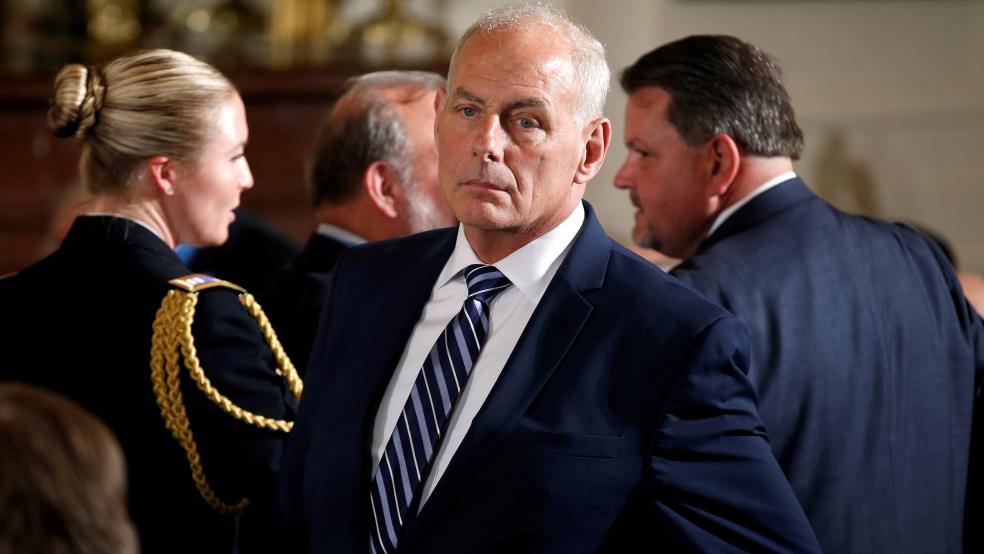President Trump’s decision to replace former White House Chief of Staff Reince Priebus with retired Marine Corps Gen. John Kelly, until recently the head of the Department of Homeland Security, is being watched closely for signs that the chaotic culture of the executive mansion is being brought under control.
On social media Wednesday morning, it was widely remarked that the president had gone nearly 24 hours without tweeting, despite his last message declaring “Only the Fake News Media and Trump enemies want me to stop using Social Media (110 million people). Only way for me to get the truth out!”
Related: Why Republicans Are Going It Alone on Tax Cuts
Axios reported on Wednesday morning that Kelly has shut off access to the Oval office for staff who until now have had walk-in privileges, and that Trump himself appears to be changing his behavior. “Even POTUS appears to be trying to impress his four-star handler, picking up his game by acting sharper in meetings and even rattling off stats.”
But while keeping the president off Twitter for a few hours and getting him to start paying attention in meetings may be progress, the real test of Kelly’s ability to get control over the White House will be whether he can instill some Marine-like discipline on a messaging system that has so far been as focused as a soccer team full of five-year-olds.
Over the past several days, for example, the White House has delivered conflicting signals about its legislative priorities in the wake of the failed attempt to repeal and replace the Affordable Care Act.
Late last week, two top administration officials, Treasury Secretary Steven Mnuchin and White House economic adviser Gary Cohn, appeared to bless the decision by Senate Majority Leader Mitch McConnell to move on from the politically toxic swamp of ACA repeal in search of a different achievement: tax reform.
Related: The Big Risk Trump Is Taking by Threatening Congress’ Health Insurance
The so-called “Big Six” — made up of Mnuchin, Cohn, McConnell, House Speaker Paul Ryan, Senate Finance Committee Chairman Orrin Hatch and House Ways and Means Committee Chairman Kevin Brady — signaled that they were ready to commit to writing tax reform legislation with the release of a set of agreed-upon general principles.
However, just days later, the director of the White House Office of Management and Budget, Mick Mulvaney, appeared on CNN’s Sunday morning broadcast and declared that it is White House “policy” that the Senate not change its focus to a different topic before dealing with health care reform.
“In the White House's view, they can't move on in the Senate,” Mulvaney said. “You can't promise folks you're going to do something for seven years, and then not do it.”
On Wednesday, Mulvaney was back on CNN, this time insisting a little less adamantly that health care is still on the table.
Related: Did Congress Just Break Up the Trump-Putin Bromance?
“We are doing our job down here. We hope the Senate does theirs, and continues to work on health care, doesn’t mean they can’t work on tax reform at the same time,” he said, adding, “Other folks are working on taxes, others are working on debt ceiling, that’s great. But I think the point is this, let’s not move on from health care just because you failed by one vote. The president isn’t giving up on health care and neither should the Senate.”
While it may not seem like such a stretch for the administration to want to see Congress pressing forward on more than one major initiative at a time, recent history shows that it simply doesn’t work that way. A Congress that is in session only a few days a week, and that will not be working at all for large parts of the month of August, has limited bandwidth, and when the White House begins pulling it in different directions, the kind of legislative momentum that leads to bills being passed can be lost.
That’s why a key signal that John Kelly has the White House under control will be his ability to get the various power centers within the administration to begin speaking with one voice when it comes to legislative priorities.
As the administration and Congress both careen toward a fall season strewn with must-pass pieces of legislation, including a debt ceiling increase and a budget resolution, the need for focus from the White House will become all the more acute, and the cost of not having it will get much higher.





